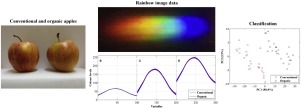当前位置:
X-MOL 学术
›
J. Food Compos. Anal.
›
论文详情
Our official English website, www.x-mol.net, welcomes your
feedback! (Note: you will need to create a separate account there.)
Evaluation of machine learning methods for organic apple authentication based on diffraction grating and image processing
Journal of Food Composition and Analysis ( IF 4.0 ) Pub Date : 2020-05-01 , DOI: 10.1016/j.jfca.2020.103437 Weiran Song , Nanfeng Jiang , Hui Wang , Gongde Guo
Journal of Food Composition and Analysis ( IF 4.0 ) Pub Date : 2020-05-01 , DOI: 10.1016/j.jfca.2020.103437 Weiran Song , Nanfeng Jiang , Hui Wang , Gongde Guo

|
Abstract Optical measuring technologies coupled with machine learning algorithms can be used to build a home-made sensor system. We built such a sensor system using a smartphone and a diffraction grating sheet. Diffraction images were captured under white light illumination and converted into a data matrix for data analysis. In this paper we present a systematic evaluation of this sensor system on the task of differentiating organic apples from conventional ones. We used the sensor system to measure 150 organic and conventional apples as rainbow images. We processed the rainbow images using computer vision techniques, built machine learning and chemometrics models, and used the resultant models to classify testing samples. Moreover, a comparative study was conducted where the same set of apples were scanned by a commercial spectrometer resulting in spectral data of the apple samples and classification was undertaken using partial least squares discriminant analysis (PLS-DA). Experimental results show that state of the art machine learning algorithms such as support vector machine (SVM) and locally weighted partial least squares classifier (LW-PLSC) are effective in handling low-quality image data with classification accuracies of 93 − 100%. These results suggest that the sensor system is convenient and low-cost, and provides a fast, effective, non-destructive and viable solution for in-line food authentication.
中文翻译:

基于衍射光栅和图像处理的有机苹果认证机器学习方法评价
摘要 光学测量技术与机器学习算法相结合,可用于构建自制的传感器系统。我们使用智能手机和衍射光栅片构建了这样一个传感器系统。在白光照明下捕获衍射图像并将其转换为数据矩阵以进行数据分析。在本文中,我们对该传感器系统进行了系统评估,以区分有机苹果与传统苹果。我们使用传感器系统测量了 150 个有机和传统苹果作为彩虹图像。我们使用计算机视觉技术处理彩虹图像,构建机器学习和化学计量学模型,并使用生成的模型对测试样本进行分类。而且,进行了一项比较研究,其中用商用光谱仪扫描同一组苹果,得出苹果样品的光谱数据,并使用偏最小二乘判别分析 (PLS-DA) 进行分类。实验结果表明,支持向量机 (SVM) 和局部加权偏最小二乘分类器 (LW-PLSC) 等最先进的机器学习算法在处理低质量图像数据方面是有效的,分类精度为 93 - 100%。这些结果表明,该传感器系统方便且成本低,为在线食品认证提供了一种快速、有效、无损且可行的解决方案。实验结果表明,支持向量机 (SVM) 和局部加权偏最小二乘分类器 (LW-PLSC) 等最先进的机器学习算法可有效处理低质量图像数据,分类精度为 93 - 100%。这些结果表明,该传感器系统方便且成本低,为在线食品认证提供了一种快速、有效、无损且可行的解决方案。实验结果表明,支持向量机 (SVM) 和局部加权偏最小二乘分类器 (LW-PLSC) 等最先进的机器学习算法在处理低质量图像数据方面是有效的,分类精度为 93 - 100%。这些结果表明,该传感器系统方便且成本低,为在线食品认证提供了一种快速、有效、无损且可行的解决方案。
更新日期:2020-05-01
中文翻译:

基于衍射光栅和图像处理的有机苹果认证机器学习方法评价
摘要 光学测量技术与机器学习算法相结合,可用于构建自制的传感器系统。我们使用智能手机和衍射光栅片构建了这样一个传感器系统。在白光照明下捕获衍射图像并将其转换为数据矩阵以进行数据分析。在本文中,我们对该传感器系统进行了系统评估,以区分有机苹果与传统苹果。我们使用传感器系统测量了 150 个有机和传统苹果作为彩虹图像。我们使用计算机视觉技术处理彩虹图像,构建机器学习和化学计量学模型,并使用生成的模型对测试样本进行分类。而且,进行了一项比较研究,其中用商用光谱仪扫描同一组苹果,得出苹果样品的光谱数据,并使用偏最小二乘判别分析 (PLS-DA) 进行分类。实验结果表明,支持向量机 (SVM) 和局部加权偏最小二乘分类器 (LW-PLSC) 等最先进的机器学习算法在处理低质量图像数据方面是有效的,分类精度为 93 - 100%。这些结果表明,该传感器系统方便且成本低,为在线食品认证提供了一种快速、有效、无损且可行的解决方案。实验结果表明,支持向量机 (SVM) 和局部加权偏最小二乘分类器 (LW-PLSC) 等最先进的机器学习算法可有效处理低质量图像数据,分类精度为 93 - 100%。这些结果表明,该传感器系统方便且成本低,为在线食品认证提供了一种快速、有效、无损且可行的解决方案。实验结果表明,支持向量机 (SVM) 和局部加权偏最小二乘分类器 (LW-PLSC) 等最先进的机器学习算法在处理低质量图像数据方面是有效的,分类精度为 93 - 100%。这些结果表明,该传感器系统方便且成本低,为在线食品认证提供了一种快速、有效、无损且可行的解决方案。










































 京公网安备 11010802027423号
京公网安备 11010802027423号